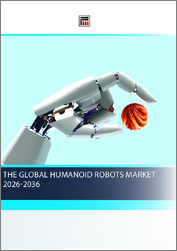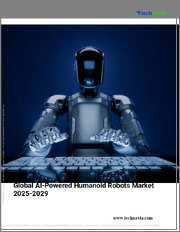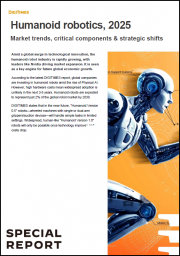
|
시장보고서
상품코드
1701466
세계의 휴머노이드 로봇 시장 규모, 점유율, 성장 분석 : 컴포넌트별, 용도별, 동작 유형별, 지역별 - 산업 예측(2025-2032년)Humanoid Robot Market Size, Share, and Growth Analysis, By Component (Hardware, Software), By Application (Personal Assistance & Caregiving, Hospitality), By Motion Type, By Region - Industry Forecast 2025-2032 |
||||||
휴머노이드 로봇 시장 규모는 2023년 24억 3,000만 달러, 2024년 31억 3,000만 달러에서 2032년 240억 4,000만 달러로 성장할 것으로 예상되며, 예측 기간(2025-2032년) 동안 29.0%의 연평균 복합 성장률(CAGR)을 보일 것으로 예측됩니다.
휴머노이드 로봇 시장은 기술 발전과 헬스케어, 제조, 엔터테인먼트, 개인 비서 등 다양한 용도에 힘입어 큰 변화를 맞이하고 있습니다. 인간의 행동을 재현하도록 설계된 이 로봇들은 노동력 부족을 해결하고 업무 효율성을 높이고 고객과의 상호작용을 개선하기 위해 도입되고 있습니다. 로봇공학과 인공지능의 발전으로 휴머노이드 로봇은 더욱 다재다능하고 일상 생활에 자연스럽게 녹아들면서 시장 확대의 원동력이 되고 있습니다. 그러나 규제 장벽, 윤리적 고려, 높은 개발 비용 등의 문제가 성장을 저해할 수 있습니다. 헬스케어에서 환자 모니터링의 역할, 학교에서의 양방향 교육 기능, RaaS(Robotics as a Service) 모델의 부상과 같은 요인들은 인간 근로자와의 협업을 촉진하고, 자금 조달, 정책, 민관 파트너십을 통해 더 많은 혁신의 길을 열어주는 주요 촉진요인으로 작용할 것입니다. 주요 촉진요인이 되고 있습니다.
목차
서론
- 조사 목적
- 조사 범위
- 정의
조사 방법
- 정보 조달
- 2차와 1차 데이터 방법
- 시장 규모 예측
- 시장 전제조건과 제한
주요 요약
- 세계 시장 전망
- 공급과 수요 동향 분석
- 부문별 기회 분석
시장 역학과 전망
- 시장 개요
- 시장 규모
- 시장 역학
- 성장 촉진요인과 기회
- 성장 억제요인과 과제
- Porter의 Five Forces 분석
주요 시장 인사이트
- 중요 성공 요인
- 경쟁 정도
- 주요 투자 기회
- 시장 생태계
- 시장의 매력 지수(2024년)
- PESTEL 분석
- 거시경제 지표
- 밸류체인 분석
- 가격 분석
- 사례 연구
- 기술 진보
- 규제 상황
휴머노이드 로봇 시장 규모 : 컴포넌트별
- 시장 개요
- 하드웨어
- 센서
- 액추에이터
- 전력
- 제어 시스템
- 기타
- 소프트웨어
- 서비스
휴머노이드 로봇 시장 규모 : 용도별
- 시장 개요
- 퍼스널 어시스턴스 및 간병
- 호스피탈리티
- 수색 구조
- 교육 및 엔터테인먼트
- 연구 및 우주 탐사
- 감시 및 보안
휴머노이드 로봇 시장 규모 : 동작 유형별
- 시장 개요
- 2족 보행
- 차륜 구동
휴머노이드 로봇 시장 규모
- 북미
- 미국
- 캐나다
- 유럽
- 독일
- 스페인
- 프랑스
- 영국
- 이탈리아
- 기타 유럽
- 아시아태평양
- 중국
- 인도
- 일본
- 한국
- 기타 아시아태평양
- 라틴아메리카
- 브라질
- 기타 라틴아메리카
- 중동 및 아프리카
- GCC 국가
- 남아프리카공화국
- 기타 중동 및 아프리카
경쟁 정보
- 주요 5개사 비교
- 주요 기업의 시장 포지셔닝(2024년)
- 주요 시장 기업이 채택한 전략
- 최근 시장 동향
- 기업의 시장 점유율 분석(2024년)
- 주요 기업 개요
- 기업 상세
- 제품 포트폴리오 분석
- 기업 부문별 점유율 분석
- 매출 전년대비 비교(2022-2024년)
주요 기업 개요
- SoftBank Robotics(Japan)
- ROBOTIS(South Korea)
- Agility Robotics(USA)
- UBTECH Robotics(China)
- PAL Robotics(Spain)
- Boston Dynamics(USA)
- Hanson Robotics(Hong Kong)
- Kawada Robotics(Japan)
- Toyota Motor Corporation(Japan)
- Honda Motor Co., Ltd.(Japan)
- Samsung Electronics(South Korea)
- FANUC Corporation(Japan)
- KUKA AG(Germany)
- ABB Ltd.(Switzerland)
- Hyundai Robotics(South Korea)
- Engineered Arts(UK)
- Tesla(USA)
- Figure AI(USA)
- Unitree Robotics(China)
- Sanctuary AI(Canada)
결론과 제안
LSH 25.05.21Humanoid Robot Market size was valued at USD 2.43 billion in 2023 and is poised to grow from USD 3.13 billion in 2024 to USD 24.04 billion by 2032, growing at a CAGR of 29.0% during the forecast period (2025-2032).
The humanoid robot market is experiencing a significant transformation, spurred by advancements in technology and diverse applications across healthcare, manufacturing, entertainment, and personal assistance. These robots, designed to replicate human behavior, are being increasingly adopted to enhance operational efficiency and improve customer interactions while addressing labor shortages. The evolution of robotics and artificial intelligence is making humanoid robots more versatile and seamlessly integrated into everyday life, which is set to drive market expansion. However, challenges such as regulatory hurdles, ethical considerations, and high development costs may temper growth. Factors such as their role in healthcare for patient monitoring, the interactive educational capabilities in schools, and the rise of the Robotics as a Service (RaaS) model are key enablers, fostering increased collaboration with human workers and paving the way for further innovation through funding, policies, and public-private partnerships.
Top-down and bottom-up approaches were used to estimate and validate the size of the Humanoid Robot market and to estimate the size of various other dependent submarkets. The research methodology used to estimate the market size includes the following details: The key players in the market were identified through secondary research, and their market shares in the respective regions were determined through primary and secondary research. This entire procedure includes the study of the annual and financial reports of the top market players and extensive interviews for key insights from industry leaders such as CEOs, VPs, directors, and marketing executives. All percentage shares split, and breakdowns were determined using secondary sources and verified through Primary sources. All possible parameters that affect the markets covered in this research study have been accounted for, viewed in extensive detail, verified through primary research, and analyzed to get the final quantitative and qualitative data.
Humanoid Robot Market Segments Analysis
Global Humanoid Robot Market is segmented by Component, Application, Motion Type and region. Based on Component, the market is segmented into Hardware, Software and Services. Based on Application, the market is segmented into Personal Assistance & Caregiving, Hospitality, Search and Rescue, Education and Entertainment, Research and Space Exploration and Surveillance and Security. Based on Motion Type, the market is segmented into Biped and Wheel Drive. Based on region, the market is segmented into North America, Europe, Asia Pacific, Latin America and Middle East & Africa.
Driver of the Humanoid Robot Market
The humanoid robot market is significantly driven by their ability to revolutionize high-risk industries by prioritizing worker safety and mitigating accidents, a pressing concern amplified by the International Labour Organization's findings of 2.3 million annual workplace fatalities, including 350,000 from accidents and 2 million due to occupational diseases. Furthermore, over 313 million workers experience serious injuries each year. By utilizing cutting-edge AI and sophisticated sensors, humanoid robots undertake perilous tasks in challenging environments, drastically reducing human exposure to hazards. This not only enhances productivity but also ensures adherence to safety regulations, underscoring the necessity for such advancements in workplace safety.
Restraints in the Humanoid Robot Market
The global humanoid robot market encounters considerable obstacles primarily due to elevated costs. Research and development expenditures can reach millions of dollars each year, reflecting the complex requirements for creating these advanced machines, which involve sophisticated artificial intelligence, machine learning, precision sensors, and diverse technical expertise. Moreover, limited production volumes and niche application markets contribute to escalating prices. The rapid pace of technological advancements poses additional risks of obsolescence, establishing both financial and adoption barriers that hinder progress for businesses and investors in this evolving field. These challenges underscore the market's hesitance in embracing widespread humanoid robotics.
Market Trends of the Humanoid Robot Market
The integration of Artificial Emotional Intelligence (EmoAI) in humanoid robots is rapidly transforming the Global Humanoid Robots Market, marking a significant trend towards emotional adaptability and enhanced human-robot interactions. EmoAI empowers robots to interpret and respond to complex human emotions, paving the way for more intuitive and empathetic robotic companions. Recent advancements, such as Columbia Engineering's Emo robot, which predicts smiles 840 milliseconds in advance, illustrate the remarkable potential of this technology. As demand for emotionally intelligent robots grows across sectors like healthcare, education, and entertainment, the market is expected to expand significantly, driving innovation and investment in humanoid robotics.
Table of Contents
Introduction
- Objectives of the Study
- Scope of the Report
- Definitions
Research Methodology
- Information Procurement
- Secondary & Primary Data Methods
- Market Size Estimation
- Market Assumptions & Limitations
Executive Summary
- Global Market Outlook
- Supply & Demand Trend Analysis
- Segmental Opportunity Analysis
Market Dynamics & Outlook
- Market Overview
- Market Size
- Market Dynamics
- Drivers & Opportunities
- Restraints & Challenges
- Porters Analysis
- Competitive rivalry
- Threat of substitute
- Bargaining power of buyers
- Threat of new entrants
- Bargaining power of suppliers
Key Market Insights
- Key Success Factors
- Degree of Competition
- Top Investment Pockets
- Market Ecosystem
- Market Attractiveness Index, 2024
- PESTEL Analysis
- Macro-Economic Indicators
- Value Chain Analysis
- Pricing Analysis
- Case Studies
- Technology Advancement
- Regulatory Landscape
Global Humanoid Robot Market Size by Component & CAGR (2025-2032)
- Market Overview
- Hardware
- Sensors
- Actuators
- Power Sources
- Control System
- Others
- Software
- Services
Global Humanoid Robot Market Size by Application & CAGR (2025-2032)
- Market Overview
- Personal Assistance & Caregiving
- Hospitality
- Search and Rescue
- Education and Entertainment
- Research and Space Exploration
- Surveillance and Security
Global Humanoid Robot Market Size by Motion Type & CAGR (2025-2032)
- Market Overview
- Biped
- Wheel Drive
Global Humanoid Robot Market Size & CAGR (2025-2032)
- North America (Component, Application, Motion Type)
- US
- Canada
- Europe (Component, Application, Motion Type)
- Germany
- Spain
- France
- UK
- Italy
- Rest of Europe
- Asia Pacific (Component, Application, Motion Type)
- China
- India
- Japan
- South Korea
- Rest of Asia-Pacific
- Latin America (Component, Application, Motion Type)
- Brazil
- Rest of Latin America
- Middle East & Africa (Component, Application, Motion Type)
- GCC Countries
- South Africa
- Rest of Middle East & Africa
Competitive Intelligence
- Top 5 Player Comparison
- Market Positioning of Key Players, 2024
- Strategies Adopted by Key Market Players
- Recent Developments in the Market
- Company Market Share Analysis, 2024
- Company Profiles of All Key Players
- Company Details
- Product Portfolio Analysis
- Company's Segmental Share Analysis
- Revenue Y-O-Y Comparison (2022-2024)
Key Company Profiles
- SoftBank Robotics (Japan)
- Company Overview
- Business Segment Overview
- Financial Updates
- Key Developments
- ROBOTIS (South Korea)
- Company Overview
- Business Segment Overview
- Financial Updates
- Key Developments
- Agility Robotics (USA)
- Company Overview
- Business Segment Overview
- Financial Updates
- Key Developments
- UBTECH Robotics (China)
- Company Overview
- Business Segment Overview
- Financial Updates
- Key Developments
- PAL Robotics (Spain)
- Company Overview
- Business Segment Overview
- Financial Updates
- Key Developments
- Boston Dynamics (USA)
- Company Overview
- Business Segment Overview
- Financial Updates
- Key Developments
- Hanson Robotics (Hong Kong)
- Company Overview
- Business Segment Overview
- Financial Updates
- Key Developments
- Kawada Robotics (Japan)
- Company Overview
- Business Segment Overview
- Financial Updates
- Key Developments
- Toyota Motor Corporation (Japan)
- Company Overview
- Business Segment Overview
- Financial Updates
- Key Developments
- Honda Motor Co., Ltd. (Japan)
- Company Overview
- Business Segment Overview
- Financial Updates
- Key Developments
- Samsung Electronics (South Korea)
- Company Overview
- Business Segment Overview
- Financial Updates
- Key Developments
- FANUC Corporation (Japan)
- Company Overview
- Business Segment Overview
- Financial Updates
- Key Developments
- KUKA AG (Germany)
- Company Overview
- Business Segment Overview
- Financial Updates
- Key Developments
- ABB Ltd. (Switzerland)
- Company Overview
- Business Segment Overview
- Financial Updates
- Key Developments
- Hyundai Robotics (South Korea)
- Company Overview
- Business Segment Overview
- Financial Updates
- Key Developments
- Engineered Arts (UK)
- Company Overview
- Business Segment Overview
- Financial Updates
- Key Developments
- Tesla (USA)
- Company Overview
- Business Segment Overview
- Financial Updates
- Key Developments
- Figure AI (USA)
- Company Overview
- Business Segment Overview
- Financial Updates
- Key Developments
- Unitree Robotics (China)
- Company Overview
- Business Segment Overview
- Financial Updates
- Key Developments
- Sanctuary AI (Canada)
- Company Overview
- Business Segment Overview
- Financial Updates
- Key Developments



















